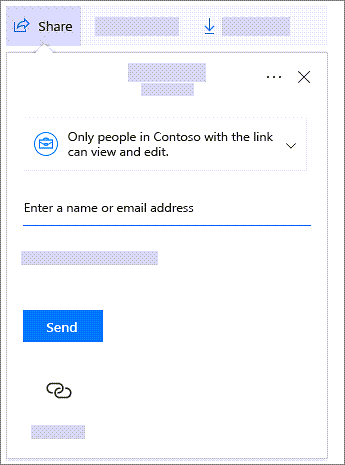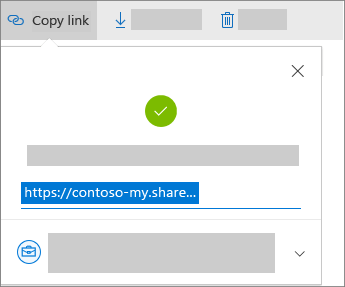Sharing files and folders in SharePoint Online
Share SharePoint files or folders
Here's how you share files or folders in SharePoint:
Select the file or folder you want to share, and then select Share.

(Optional) Click the dropdown list to change the type of link. The Details pane opens, where you can change who can access the link and whether people can edit the item you’re sharing.
Options for Who would you like this link to work for:
People in <Your Organisation> gives anyone in your organization who has the link access to the file, whether they receive it directly from you or forwarded from someone else.
People with existing access can be used by people who already have access to the document or folder. Use this if you just want to send a link to somebody who already has access.
Specific people gives access only to the people you specify, although other people may already have access. If people forward the sharing invitation, only people who already have access to the item will be able to use the link.
Note: If a sharing option has been grayed out, they may have been restricted for security reasons.
By default, Allow editing is turned on. If you want people to only view your files, uncheck the check box.
When you're done, click Apply.
Enter the names of the people you want to share with and a message, if you want.
When you’re ready to send the link, click Send.
Note: When sharing a file, if you select the Outlook option, this only allows you to include a link to the file in the email message. If you want to attach the actual file, you must download a local copy from SharePoint, then attach the file to the email.
Get a link to a file or folder that you can copy
Another way to share is to get a link to a file or folder that you can copy and paste in a text message or on a website. People you share these links with can also forward your link to others.
In SharePoint, click Copy link. The link is automatically copied to your clipboard.

(Optional) Click the dropdown list to change the type of link. The Details pane opens, where you can change who can access the link and whether people can edit the item you’re sharing.
Options for Who would you like this link to work for (options vary based on admin settings):
Anyone gives access to anyone who receives this link, whether they receive it directly from you or forwarded from someone else. This may include people outside of your organization.
People in <Your Organisation> gives anyone in your organization who has the link access to the file, whether they receive it directly from you or forwarded from someone else.
People with existing access can be used by people who already have access to the document or folder. It does not change the permissions on the item. Use this if you just want to send a link to somebody who already has access.
Specific people gives access only to the people you specify, although other people may already have access. If people forward the sharing invitation, only people who already have access to the item will be able to use the link.
By default, Allow editing is turned on. If you want people to only view your files, uncheck the check box. This can be further restricted by selecting the option to Block download, which means they cannot save a local copy.
When you're done, click Apply.
Paste the link (Ctrl+V) to wherever you want, such as a text message or on a website.
Notes:
The permission granted by a sharing link lasts only as long as the link exists. For example, when a link is disabled, access is revoked (though people may still have access to the file via other means).
When Allow editing is selected: After they sign in, people in your organization can edit, copy, or download the files. When Allow editing isn’t selected, people in your organization can view, and may be able to copy or download the files.
Site administrators can restrict sharing so that only owners can share files and sites.
If site administrators have not restricted sharing to site owners, any user with Edit permissions to a file or folder can share that file or folder with others by clicking Share or Copy link. Users who don't have edit permissions can use Copy link to get a link that will work for users who already have permissions to the file or folder.
Related Articles
Getting Started with Sharepoint Online
Get started with SharePoint Online When you sign in to Office 365, or your organisation’s SharePoint site, click SharePoint in the app launcher navigation or top bar. These are your entry points into SharePoint. What's in a SharePoint site ...How to copy or share a link to a file within SharePoint Online
How to copy or share a link to a file within SharePoint Online 1) Open of the document library where the file is located in which you would like to copy. 2) Within that document library, highlight over the file you would like to copy or share a link ...How to save a copy of a file in SharePoint Online
How to save a copy of a file in SharePoint Online This knowledge base article will help you to save a copy of a file inside of SharePoint Online. 1) Open up the document library that the file is located in which you would like to copy. 2) Once you ...Chromebook Logging in and USB Files
Following the initial setup of the Chromebook, please follow this instruction to log in and access SharePoint (Staff Hub) resources. There will be a supplemental part at the end to explain accessing USB Device Files. Do not log the Chromebook or ...How to attach a file from SharePoint through the Outlook Web App
How to attach a file from SharePoint through the Outlook Web App In this article you will learn how to attach a file from SharePoint into an email using the Outlook Web App. 1) Log into the Outlook Web App at outlook.office.com. 2) Once logged in ...